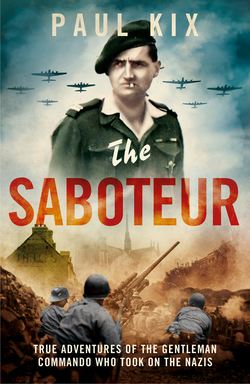Читать книгу The Saboteur: True Adventures Of The Gentleman Commando Who Took On The Nazis - Paul Kix, Paul Kix - Страница 13
CHAPTER 6
ОглавлениеThe idea had come in the spring of 1938. Hitler had annexed his native Austria and was now eying other countries, and a few people in the British government began to consider something called “clandestine warfare” to combat the threat. The government secretly established three authorities. The first, overseen by the Foreign Office and ultimately called the Political Warfare Executive, developed propaganda to influence German opinion. The second, an outgrowth of MI6 called Section D, considered German targets vulnerable to sabotage and the sort of people who might do the work. The third was little more in the beginning than two officers and a typist, but it became MI(R), which studied how guerrilla fighting—light equipment, evasive tactics, high mobility—might shape future wars.
Section D worked on time fuses for explosives and helped convince senior civil servants that there really should be a secret agency dealing in sabotage overseas. This was a concept “until that time unheard-of,” as one author noted. MI(R) helped form an understanding of what it would mean to train foreign soldiers in guerrilla tactics. This was equally novel and just as fascinating, because a superpower like Britain had historically defended itself against such threats.
For as long as there had been war, in fact, there had been guerrilla warfare. The Jews in the bushes above the narrow mountain paths outside Beth Horon had “covered the Roman army with their darts” in AD 66, in the words of the historian Josephus, forcing the empire to retreat from its advance to the Mediterranean coast. The “fast moving and light armed” natives of northwestern Greece had destroyed the armored Athenians. The Spanish resistance of the Peninsular War (1807–14)—from which the modern-day term guerrilla derives—repelled Napoléon’s army. The British lost first to a Revolutionary American militia composed in part of farmers who blended into the population, then to Pashtun tribes whose “pin-pricking hit-and-run tactics” didn’t really cease until India’s independence, and nearly lost to the elusive Boers in South Africa at the turn of the twentieth century.
Asymmetrical fighting was in fact so well established that the first counterinsurgency manual emerged in 600 AD, while the most famous guerrilla tract was T. E. Lawrence’s The Seven Pillars of Wisdom, the book based on his experiences in World War I helping disparate bands of Bedouin tribesman push the mighty Turks out of Arabia. But by the outset of World War II, even though Lawrence’s colleagues had survived, the agencies that had supported them had not. So, in May of 1940, with the situation in France worsening, the British chiefs of staff looked to the fledgling Section D and MI(R), and recommended to the war cabinet a new and “special organization” that could create “widespread revolt in [Germany’s] conquered territories.”
By July 2, with the armistice in France signed and Britain standing alone against a continent of Nazis, Minister of Economic Warfare Hugh Dalton wrote a letter to Britain’s foreign secretary, Lord Halifax, continuing the theme of the earlier recommendation:
We have got to organize movements in enemy-occupied territory … This “democratic international” must use many different methods, including industrial and military sabotage, labour agitation and strikes, continuous propaganda, terrorist acts against traitors and German leaders, boycotts and riots … What is needed is a new organization to coordinate, inspire, control and assist the nationals of the oppressed countries who must themselves be the direct participants. We need absolute secrecy, a certain fanatical enthusiasm, willingness to work with people of different nationalities, complete political reliability … The organization should, in my view, be entirely independent of the War Office machine.
For two weeks the cabinet debated this secret organization. At last the outgoing prime minister, Neville Chamberlain, who had appeased Hitler in 1938 by giving him Czechoslovakia without a fight, signed a “most secret paper,” one of the last of his life, and one that would have begun to redeem his reputation had anyone known of it. Chamberlain said that, on the authority of the prime minister, “a new organization shall be established forthwith to coordinate all action, by way of subversion and sabotage, against the enemy overseas … This organization will be known as Special Operations Executive.”
The document became SOE’s founding charter, and its passages—explicitly stated or implied—charged the agency with many responsibilities. First, SOE would train the foreign nationals flooding England’s shores in accepted and many unaccepted styles of war, and then parachute these fighters back to their occupied countries, where they would assassinate high-ranking Germans, sabotage the factories that made Nazi weaponry and the trains that transported it, and recruit other like-minded natives to the cause of liberation. Furthermore, inside enemy lines, SOE would drop tons of firearms, ammunition, explosives, and money near the camps of known Resistance groups, so that they might continue their anarchic efforts and draw out the men and women who wanted to fight but by dint of circumstance couldn’t get to London.
Really, the world had seen nothing like SOE. Yes, guerrilla warfare had been around for millennia, but it had been exercised locally, by small and often subjected bands of people, not administered by a foreign superpower that first trained and equipped and then sent back the rebel fighters who might free their countries from Nazi subjugation. For that reason alone, SOE was remarkable. But the agency had even greater ambitions, and here it’s important to return to T. E. Lawrence. While Lawrence served as SOE’s spiritual father, his actions in the Arabian desert in 1917 and ’18 were often of his own devising
